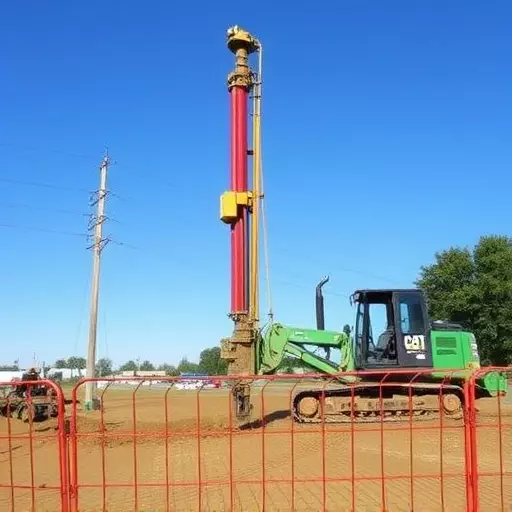Underground utility installation has been transformed by Trenchless Technology, especially Directional Boring and Horizontal Directional Drilling (HDD). These advanced methods offer significant advantages over traditional excavation, including reduced environmental impact, faster timelines, and lower costs. Directional Boring Toledo, a specialized form of HDD, enables utilities to be installed or replaced without large trenches, minimizing disruption to urban surfaces around obstacles like structures and pipelines. This technology is especially beneficial in dense urban areas, enhancing safety, reducing traffic congestion, and conserving resources while facilitating faster construction, lower labor costs, and minimal environmental damage.
Underground Utility Installation has evolved with the advent of trenchless technology, revolutionizing how we access and replace critical infrastructure. This article delves into the world of Directional Boring Toledo and Horizontal Directional Drilling (HDD), highlighting their benefits and advantages in urban environments. We explore techniques that enable efficient operations, backed by real-world case studies showcasing successful trenchless utility implementations in complex scenarios. Discover how these innovations are reshaping the landscape of underground construction.
- Understanding Trenchless Technology and its Benefits
- The Role of Horizontal Directional Drilling (HDD) in Underground Utility Installation
- Advantages of Directional Boring in Toledo and Similar Urban Environments
- Equipment and Techniques for Efficient HDD Operations
- Case Studies: Successful Implementation of Trenchless Utilities in Complex Environments
Understanding Trenchless Technology and its Benefits

Underground Utility Installation has seen a significant evolution with the advent of Trenchless Technology, particularly in techniques like Directional Boring and Horizontal Directional Drilling (HDD). These innovative methods offer numerous benefits over traditional excavation methods, such as reduced environmental impact, faster project completion times, and lower costs.
Directional Boring Toledo, for instance, allows utilities to be installed or replaced without the need for large trenches. This non-invasive approach minimizes disruption to roads, sidewalks, and other above-ground structures. Horizontal Directional Drilling further enhances this by enabling utilities to be directed around obstacles like buildings, trees, and existing pipelines. By embracing Trenchless Technology, underground utility installation becomes more efficient, safer, and environmentally friendly.
The Role of Horizontal Directional Drilling (HDD) in Underground Utility Installation

Underground Utility Installation has seen a significant evolution with the advent of Trenchless Technology, particularly Horizontal Directional Drilling (HDD). This innovative method offers a precise and efficient alternative to traditional excavation methods, such as digging deep trenches. HDD utilizes advanced machinery to create horizontal boreholes beneath the surface, allowing for the installation or replacement of utilities like pipes, cables, and conduits without disrupting the surrounding area.
Directional Boring Toledo, a specialized form of Horizontal Directional Drilling, has gained prominence due to its ability to navigate through diverse terrain and obstacles. This technique is particularly beneficial in urban settings where space is limited and the risk of damaging existing infrastructure is high. By employing this method, construction projects can be completed faster, with reduced costs and minimal disruption to local communities, making it a preferred choice for modern utility installations.
Advantages of Directional Boring in Toledo and Similar Urban Environments

In urban areas like Toledo, where infrastructure is dense and space is limited, directional boring offers a number of significant advantages over traditional excavation methods. This innovative trenchless technology allows for the installation or replacement of underground utilities, such as water, gas, and electrical lines, without the need for deep trenches or massive equipment. By utilizing horizontal directional drilling (HDD), contractors can complete projects with minimal disruption to roads, sidewalks, and other structures, reducing traffic congestion and preserving the aesthetic and functional integrity of urban landscapes.
Furthermore, directional boring enhances safety by minimizing the risk to workers and nearby residents. Without large excavation sites, there’s less chance of accidents involving heavy machinery or utility lines. This method also conserves natural resources by requiring less material removal and reducing the environmental impact of construction projects. The versatility and precision of HDD make it a preferred choice for urban environments, ensuring efficient, cost-effective, and sustainable underground utility installations.
Equipment and Techniques for Efficient HDD Operations

In the realm of underground utility installation, efficient Horizontal Directional Drilling (HDD) operations are pivotal for successful and cost-effective projects. The Directional Boring Toledo, a cutting-edge tool, plays a crucial role in this process. This technology allows for precise excavation without disturbing the surface, making it ideal for urban settings where traditional digging methods can cause significant disruptions. With advanced sensors and real-time tracking capabilities, operators can navigate through complex underground landscapes, ensuring minimal damage to existing infrastructure.
The use of Trenchless Technology, facilitated by HDD techniques, offers numerous benefits. It eliminates the need for large trenches, reducing construction time, labor costs, and environmental impact. Moreover, it allows for the installation or repair of utilities, such as pipes and cables, in a seamless and non-invasive manner. This method is particularly valuable for municipal projects, infrastructure upgrades, and retrofitting endeavors where accessibility and minimal disruption are paramount considerations.
Case Studies: Successful Implementation of Trenchless Utilities in Complex Environments

In recent years, the successful implementation of trenchless utility installation techniques has transformed the way we approach complex infrastructure projects. One notable example is the adoption of Directional Boring in Toledo, Ohio. This innovative method involved using Horizontal Directional Drilling (HDD) to install new utilities beneath existing roads and structures without the need for traditional trenching. The project was a game-changer due to its minimal disruption to the urban environment, significantly reducing traffic congestion and construction delays.
The case study of Toledo’s directional boring project highlights the advantages of trenchless technology, such as reduced labor costs, faster completion times, and lower risk of damage to nearby utilities. This approach is particularly valuable in densely populated areas where traditional excavation methods can be logistically challenging and disruptive. As a result, Horizontal Directional Drilling is increasingly recognized as a versatile solution for various utility installations, offering a more efficient and sustainable alternative to conventional trenching techniques.


